Last weekend I had the pleasure of attending, and presenting at, the Apple Global Leadership Summit in Hong Kong. I knew it was going to be great after presenting at the Think Ahead Roadshow here in Bangkok in February, but I don’t think I realized just how great it was going to be. Of course, there are some things I would have changed (more on that in my next post), but thinking back to all of the educational events I have attended this year (and I’ve been to quite a few), I think this one was the best! And I think I’ve figured out why.
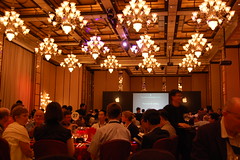 Last month I attended the EARCOS Teacher’s Conference (ETC) and left feeling a little disappointed. It was great for networking (and relaxing, given the stunning location), but it wasn’t really what I was looking for in a conference, content-wise.
Last month I attended the EARCOS Teacher’s Conference (ETC) and left feeling a little disappointed. It was great for networking (and relaxing, given the stunning location), but it wasn’t really what I was looking for in a conference, content-wise.
To be honest, I was starting to feel a little disillusioned with conferences in general this year. The effort it takes to get to the conference location, the costs involved, the exhaustion coming back to work after a full weekend of conferencing. It was starting to seem a little too much for me, considering how much I can learn relaxing on my couch, at home, in my PJs, thanks to my PLN.
But, last weekend changed my mind. While reflecting on my two very different conference experiences over the last month, I realized there are a few things conferences need to have in order to make the expense and the effort worth the trip:
Focused Content
Maybe this is just an international school thing, but I find so many conferences try to be everything to everyone (and so do schools, for that matter). They want to have sessions specifically for every discipline area, every educational trend, leadership, third culture kids, global issues, etc, etc.
In doing so, it can be hard for one person to fill up each day with directly relevant sessions – there are only so many presenters on in each given session, chances are there won’t be one directly related to my area of interest in every session. By stretching the topics so thin, in order to meet everyone’s needs, the conference often ends up meeting no-one’s needs. Sure, one presentation a day, maybe, but is that really worth the trip?
The Apple Leadership Summit was so clearly focused on the way that learning has changed, and the ways we need to prepare for the future, that I was engaged from the first moment until the last. All keynote speakers had specific experience that directly related to the changes we need to make in education – even though they all approached the topic from different perspectives, it was immediately clear how all of their expertise was directly related to the future of education. None of the sessions during the entire 3-day event strayed from the topic.
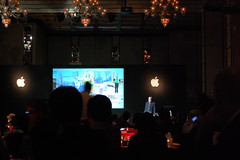 Stephen Heppell’s keynote during the (sumptuous) banquet set the tone for the weekend by sharing specific examples (and so many pictures) of schools that are changing with the times and embracing non-traditional school infrastructure (physical structure and well as curriculum design).
Stephen Heppell’s keynote during the (sumptuous) banquet set the tone for the weekend by sharing specific examples (and so many pictures) of schools that are changing with the times and embracing non-traditional school infrastructure (physical structure and well as curriculum design).
His emphasis on adaptability, flexibility, openness, and learning communities (instead of “schools”) brought the challenges of education in the 21st century to the forefront, along with visual, practical ideas for moving towards solutions.
His vision and passion for learning, in all forms and contexts, was an inspiring way to begin the conference. Having seen Learning to Change, Changing to Learn dozens of times, it was such a privilege to hear him speak directly about his experiences and to see the full range of his work and to begin to get a picture of what kinds of changes are next for education.
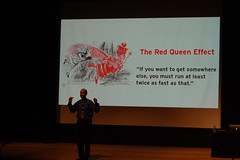 The following day, Tom Kelley brought his extensive experience with innovation to the field of education. His focus on risk-taking, seeing with new eyes (“vuja de,” in his words), prioritizing innovation, and recognizing the rate of change gave solid, real-world examples, which directly illuminated and enriched Stephen’s more philosophical presentation the day before.
The following day, Tom Kelley brought his extensive experience with innovation to the field of education. His focus on risk-taking, seeing with new eyes (“vuja de,” in his words), prioritizing innovation, and recognizing the rate of change gave solid, real-world examples, which directly illuminated and enriched Stephen’s more philosophical presentation the day before.
Being able to see with such clarity the way innovation and different modes of thinking (from his new book The 10 Faces of Innovation) can impact pretty much every field (from advertising, to hospital care, to product design, to kids toothbrushes!) helped create more concrete understandings of how critical risk taking is for education. He made it so clear that we can spend forever improving what we’ve already got, but what we really need to do is look at the whole experience of learning with fresh eyes.
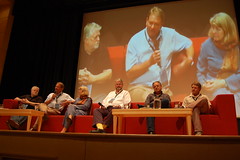 After a presentation on developing a global mindset from Vivien Stewart (much of which is already happening in many international schools), we had a choice of 3 breakout sessions with each of the keynote speakers – a great way to go more in depth with the content presented in their first sessions.
After a presentation on developing a global mindset from Vivien Stewart (much of which is already happening in many international schools), we had a choice of 3 breakout sessions with each of the keynote speakers – a great way to go more in depth with the content presented in their first sessions.
Next, was a panel discussion from all keynote speakers plus a few special guests including Greg Whitby, John Couch, Daniel McCormak, Richard Swart, and John Wray (thanks to @mrdinhk for that final name!). This was a good time to ask those burning questions that came up during the keynotes and breakout sessions earlier that day. It was very interesting to get several perspectives on the same topic, especially because each panel speaker was coming from such different backgrounds. For me the highlight was hearing Richard Swart, principal of Nanjing International School, speak so passionately about the need international schools to move forward with the ideas presented at the Summit without delay, to stop wasting time worrying about the way we’ve always done it, but to envision the future and create it, now.
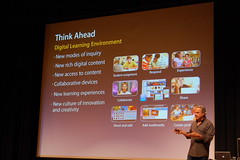 Finally, at the end of a long day of plenary sessions (by the way, most of my ideas for improvement spring from being seated the entire day in pretty much the same room, more to come in my next post), John Couch shared Apple’s vision for education in the 21st Century.
Finally, at the end of a long day of plenary sessions (by the way, most of my ideas for improvement spring from being seated the entire day in pretty much the same room, more to come in my next post), John Couch shared Apple’s vision for education in the 21st Century.
I had seen some of his slides before, but it amazed me, yet again, how ironic it is to be hearing from a vendor the most relevant, forward-thinking, pedagogically sound ideas for education. It hit home for me (again) that if these are the people making the computers, these are the computers we should be using in our schools. This vision for education, which I so passionately believe in, is so clearly wrapped up in the package that is Apple.
 On the last day, we had one final keynote from Macro Torres, after all of the fantastic ADE-led break-out sessions. His extensive experience in the classroom, combined with his fresh perspective and boundless creative energy definitely ended the weekend on a high note.
On the last day, we had one final keynote from Macro Torres, after all of the fantastic ADE-led break-out sessions. His extensive experience in the classroom, combined with his fresh perspective and boundless creative energy definitely ended the weekend on a high note.
Marco so clearly understands how important it is that our students become innovative, creative, creators of content, and how critcal it is to change the classroom environment from our traditional factory model to that of an engaging and empowering studio experience.
Conference Size
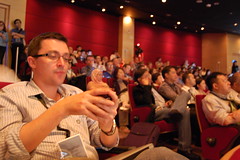 I guess because it is so difficult to actually run (and finance) a conference, the organizers prefer to have as many attendees as possible. Unfortunately, this only ends up watering down the event – trying to appeal to all interests, abilities, needs, and levels of understanding.
I guess because it is so difficult to actually run (and finance) a conference, the organizers prefer to have as many attendees as possible. Unfortunately, this only ends up watering down the event – trying to appeal to all interests, abilities, needs, and levels of understanding.
Having a limited number of participants (in the case of the HK Summit, it was 500 people), helped create a much more personal and intimate feel. With a few small changes in the agenda, I probably would have been able to meet and speak to pretty much every single person at the Summit. How often can you say that about a conference?
For example, Alex (my husband) and I had the pleasure of meeting Tom Kelley at the banquet dinner, and he was amazed at how close our community of learners is, given that we are spread out throughout the region. Personally, I was on a little bit of a geeked-out high because I knew someone (or a few someones) at almost every table. It was like a geeky international school teacher reunion for me!
Shared Vision
Limiting the number of participants, and sending out direct invitations, also helped create an environment where most (if not all) of the attendees shared the same vision for education. Therefore, the purpose of our coming together was not so much to learn what has changed, or decide what we think, but more what we can do about it.
We came approaching these ideas presented from the same perspective and the Summit was about how we can continue to move forward, not just about taking the first step. Talk about an important opportunity to network! These are clearly the people that will lead the charge in international schools to change our educational system.
Stimulating Content
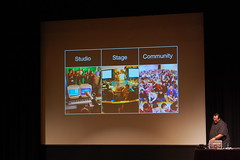 Having focused content, with a smaller group of people who shared a similar vision for education, directly influenced the level of information shared. No need to focus on introducing the changes the 21st century has brought to society, time wasn’t wasted convincing the participants that technology is crucial to learning, no one needed to be convinced that education needs to change to meet the demands of today’s learner and today’s society. Not that I don’t enjoy hearing all those things explained, helping reinforce my own ideas and clarify my thinking. But, I much prefer to have my thinking pushed to a new level, to hear new ideas that build on my current understandings, and to interact with others who are at a similar place in their learning.
Having focused content, with a smaller group of people who shared a similar vision for education, directly influenced the level of information shared. No need to focus on introducing the changes the 21st century has brought to society, time wasn’t wasted convincing the participants that technology is crucial to learning, no one needed to be convinced that education needs to change to meet the demands of today’s learner and today’s society. Not that I don’t enjoy hearing all those things explained, helping reinforce my own ideas and clarify my thinking. But, I much prefer to have my thinking pushed to a new level, to hear new ideas that build on my current understandings, and to interact with others who are at a similar place in their learning.
Location, Location, Location
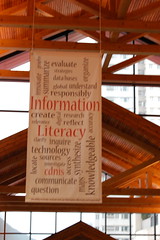 One of the most subtle, yet powerful, ways that the Summit was successful was the choice of location: Canadian International School of Hong Kong. This school exemplifies everything that the Summit was about. From the staff training room, to the 1:1 Apple laptop program, to the prominent signage, to their Year of Information Literacy focus, CDNIS clearly demonstrated a school that shares and practices a 21st century vision for education.
One of the most subtle, yet powerful, ways that the Summit was successful was the choice of location: Canadian International School of Hong Kong. This school exemplifies everything that the Summit was about. From the staff training room, to the 1:1 Apple laptop program, to the prominent signage, to their Year of Information Literacy focus, CDNIS clearly demonstrated a school that shares and practices a 21st century vision for education.
Every time I turned a corner (or hiked up another flight of stairs), I saw evidence of inquiry-based learning, the IB PYP, MYP and DP in action, 1:1 learning, and most importantly: a clear, visible, tangible, achievable vision for the school being implemented every day. A vision that represents the most important aspects of the Hong Kong summit in action. This is what we need to see from a conference: what the ideas look like in practice.
Final Thoughts
So, once again, Apple hits a home run. (Oh, did I mention the conference itself was free?) I hope it becomes an annual event!
In your opinion, what are the factors that make a conference worth the effort, time and expense?





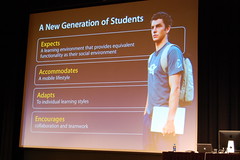

Kim,
Thanks for you soooo complete summing up of your experience in HK – I had been following the conference on Twitter and knew that it was good and I was interested after your post earlier in the year about how you found it … now I know.
I’m glad you enjoyed it and found it so worthwhile! I have been lucky enough to here Hepple and marco a couple of times and thay are good value!!
I have already contacted a few mates at Apple Oz and challenged them to improve their offerings here .. they say they are!! I’ll pass on your comments!!.
Loved reading about this. I think I clicked on every link to find out more information. How lucky you were to be a part of it!
Great read, superbly written, and filled w/ valuable information. Posts like this only re-confirm why this is one of the best “techy” blogs on the web today!!!
Kim, you very eloquently and thoughtfully summed up the success of the Apple Leadership Summit in your post. Thanks for sharing this. What stands out to me most about the conference and your summary here was the “Focused Content” (not trying to be everything to everybody) and “Stimulating Content” (pushing thinking to a new level, rather than “convincing”)! Thanks for this post, your points should be shared with all planning a conference!
@Mickprest,
We were so lucky to have so many active online participants throughout the conference, both physically at the conference and from a distance. I feel like this is the most well-documented conference I’ve attended in a long time :) I hope Apple Oz comes through for you!
@Christine,
So glad the post was helpful! I need to add descriptions to all those Flickr pictures so that they make a little more sense :)
@David,
Wow, I’m so flattered! Thank you so much for your kind words :)
@Sara,
We were so lucky we were able to go, weren’t we!